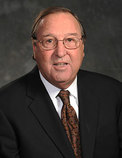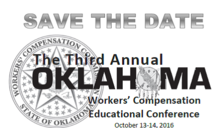|
Having trouble viewing this email? View it as a webpage.

|
|
|
|
 From the Chairman
On June 16, 2016, the Worker’s Compensation Commission (WCC)
submitted its 2015 Annual Report to the Governor and the Legislature pursuant
to the provisions of 85A §§ 25 and 101. You may access the report here: 2015
Oklahoma Workers' Compensation Commission Annual Report.
There are several highlights to the report:
-
Table 4 on page 15 presents a historical
overview of the workers' compensation system since 1989, including the past two
years under the Commission.
- During 2015, 4,698 hearings and 17,149 prehearing
conferences were set.
-
Our Counselor Division advised 11,247 members of
the public including 7,740 workers.
-
To ensure that Oklahoma employers have the
required workers' compensation coverage for their employees, the WCC Compliance Division
conducted 110 investigations, issuing 27 proposed judgments. Total collections
were $362,386.
- The Commission maintains, through our Insurance
Services Division, an online system for coverage verification which can be
found on the Commission website: www.ok.gov/wcc.
The Commission’s Insurance Services Division also regulates self-insured
employers, group self-insured’s and third-party administrators.
-
There were 254 orders for compensability and 188
orders where the claim was denied. A total of 2,296 orders approving joint
petitions were entered.
I urge all stakeholders to review the 2015 Annual
Report to become apprised of the work of the Commission.
Bob Gilliland, Chairman
|

Plan to attend
the 2016 Oklahoma Workers' Compensation Educational Conference, October 13-14
at the Embassy Suites Norman, Hotel & Conference Center. Early
bird registration opens online July 1st. For registration
information or if you are interested in being a sponsor or exhibitor, click
here.
|
Easily Reach the Commission Staff You Need
Need help? Call 405-522-3222 and select from the following menu to reach the staff member that best can help you!
-
If
you are an injured worker, employer, or other party with questions about
a
claim or work injury, choose option #1.
-
If
you are a medical provider with questions about the medical fee schedule
or
rules regarding reimbursement, choose option #2.
-
If you need a case number or information
about forms, choose option #3.
-
For questions related to docketing or
attorney leave, choose option #4.
-
If you have a question
or information regarding an order or Independent Medical Examiner, choose option #5.
-
For question about self-insurers, own risk, or affidavits of exemption, choose
option #6.
Regulations and Administrative Rules
The Commission's current proposed Administrative Rules will be effective September 11, 2016.
To view the proposed rules
Certificate of Non-coverage
The Application for the Certificate of Coverage was approved by the Commission
in April and may be found on the Commission's website www.ok.gov/wcc, on the Forms
tab. Please note that, according to Title 85A O.S. § 36, a certificate may be issued only to a sole proprietor or
a partner in a partnership. Please also note
that an employer that is an LLC or incorporated is NOT a sole proprietor, even
if the business is owned by one person or the business has only one employee.
However, Title 85A O.S. § 8(B) may offer some relief to those who do not
qualify as a sole proprietor. Additional information regarding what counts as a sole proprietor is located online with the Secretary of State.
|
|
|
Oklahoma Workers’ Compensation Commission
OKC
Location
(405) 522-3222
1915 N Stiles Ave, 231
Oklahoma City, Oklahoma 73105
Tulsa
Location
(918) 295-3732
212 Kerr State Office Bldg.
440 South Houston
Tulsa, Oklahoma 74127
W9 Now Online
The
Business Office is pleased to inform you that the Commission’s W9 is now
accessible through our website. To view the form
Employees and Employers
Informational materials for employees and employers are available on our website: www.ok.gov/wcc.
Attorney Leave Requests
Attorney
Leave Requests to the Commission and Court of Existing Claims can now
be submitted via the Commission's website. To the view the page, click
here: Attorney Leave Request.
Please be advised that a request made with less than 7 weeks' notice,
to the Commission and Court of Existing Claims, is late and hearing(s)
might already be noticed. No hearing(s) that were noticed will be reset
without the judge's approval. If you have any questions, please contact
Docket Supervisor, Valerie Rossiter at 405-522-3222.
For Commission
Public Meetings
Electronic Form Filing
Save time and postage by filing your CC-Form-4 Report of Compensation Paid online on our website www.ok.gov/wcc under electronic forms. If you choose, you may receive an email confirmation with a unique submission number and a time date stamp. Submitting online simplifies the process but if you have any issues, please call the Counselor Division 522-5308 or toll-free
1(855) 291-3612.
Handbooks
Commission handbooks can still be purchased. The handbook contains a copy of Title 85A of the Oklahoma Statutes, along with the Commission's permanent rules, hearing conduct rules, disability benefit charts, maximum compensation rates, a summary of
the Commission's forms, and crosswalks/disposition tables from the prior law to the new.They are available for $45.00 each and can be purchased with cash, check or credit card at our OKC location or with cash or check at our Tulsa location. They can also be mailed; you will be responsible for shipping charges. Contact Purchasing@wcc.ok.gov for more information.
Self-insured
Own Risk Employers
Please
note there is an updated application located on the Commission’s website, www.ok.gov/wcc, under the
Forms tab. The
application is titled
Form – SI Employer.
There is also an updated Form-7,
Designation of Service Agent, on the same page, titled CC-Form 7.
Please begin using both of these updated
forms.
Sign up Now for Updates
Please check out our website www.ok.gov/wcc to sign up for the latest news and updates. Simply indicate whether you want the update by text or email, then check your subscription preferences and you are all set to be fully informed on Commission activities.
|
|
|
 From the Bench
These
are exciting and challenging times for myself and the other Administrative Law
Judges as the appellate courts give us guidance and direction on the
application of the Workers' Compensation Act. We are seeing an increase in the
number of hearings, particularly in the area of the extent of disability to
scheduled members. Even more cases will be heard once other appellate issues
are decided. One of my primary goals (and I am sure the other judges would
agree) is the expeditious and effective resolution of disputes and delivery of
benefits. To make hearings more efficient, it is imperative that these hearings
(trials) be run more efficiently. An easy way for a hearing to be streamlined
is if all parties understand the stipulation process at the beginning of each
hearing. Here are some suggestions based on what I have noticed from the bench
over the past two plus years:
Claimant
- Advise the Commission ALJ at the hearing as to what specific benefits are
being sought. State all of the requested body parts, even if some of them are
denied or reserved. If TTD benefits
are requested, give the starting date and end date, unless continuing benefits
are sought. State the basis for the payment of the requested TTD benefits.
Stipulate (if possible) to the compensation rates. If PPD benefits are being
requested, provide the accrual date to the judge. If you have any legal
arguments, provide the ALJ with the statutory citation.
Respondent - Respond
to all of the issues raised by the Claimant. Advise whether the claim is
admitted or denied in whole or in part. Any legal defenses should be cited
appropriately to the pertinent statute (if applicable). If there are any issues
with the accrual date or the compensation rates, these should be brought to the
attention of the ALJ.
All parties should
attempt to provide the Commission with all relevant medical and factual
information in a neat and orderly fashion. This includes treating medical
records, historical medical records from prior injuries, accident reports and
prior workers' compensation cases. The parties should advise the ALJ during
early pre-hearing conferences if additional witnesses need to be called or if
any preliminary issues need to be addressed (i.e. mediation, appointment of an
independent medical examiner, Insurance coverage, etc.).
I appreciate the
professionalism and legal skills of the members of the bar that appear before me. Although I have
been active in this area of the law for over three decades, I now have a new
perspective from the bench. With an increase in case activity undoubtedly on
the horizon, I would recommend reviewing the above suggestions. This should
helpfully help make the system more efficient and productive.
Michael T. Egan
Administrative Law Judge
|
 Medical Report
Medical Director Jay P. Cannon
Commissioner Young has assembled a group of 16
stakeholders to discuss and review possible revisions
of the Medical Fee
Schedule, as required by statute. Two
meetings have been held and a final meeting is scheduled for August. The group plans to have a proposal for
the Commissioners to review in the Fall. The agenda for the Annual Worker’s Compensation Conference has now been
completed. There will be educational opportunities for physicians, case
managers, and attorneys provided during the two day meeting.
|

Legislative Update
It was a
frustrating legislative session for the Workers’ Compensation Commission. The Title 85A cleanup bill was not heard by the Senate Judiciary Committee,
though there appeared to be no opposition to its provisions. That language was
then placed in a workers’ compensation omnibus bill in the House, but that bill
was caught in a last week of session political stand-off, and was not allowed
to come out of conference.
The 30
or so provisions of the clean-up bill were non-controversial, did not affect
workers’ compensation benefits in any way, or have any effect on overall
policy. They merely streamlined, simplified or clarified existing provisions.
An example would have to been to allow the commissioners to appoint an existing
administrative law judge, who had not presided over any of the previous
hearings on the claim, to the en banc
panel when a commissioner is absent or conflicted out of a case. This
would have saved money by eliminating the need for hiring special
commissioners.
The other
frustration this session was the funding mechanism for the Workers’
Compensation Commission. This bill would have restored the Commission’s funding
from the $3M limitation placed in statute in 2015, to its actual $5M operating
budget. The Commission is not funded from general revenue, but from the tax on
workers’ compensation premiums. Because it is a tax, those funds are restricted
to workers’ compensation purposes, and cannot be used for any other state
purpose. Fortunately, the Commission has managed, through efficient operations
and severely conservative hiring, to set aside funds this fiscal year with the
intent to replace its antiquated and inefficient case management system. That
project will now have to be delayed for another year and those funds used to
enable operations for this fiscal year.
Mark Liotta, Commissioner
|

What is
Behavior-Based Safety?
Part 2 of a 3-part Series
Clif Cypert, Human Resources Director
MHR, SPHR, SHRM-SCP
We left off last quarter with an
introduction to Behavior-Based Safety in general terms and the benefits of such
a program. This quarter, we’ll dive into the details a little more. You may
remember the definition provided in the previous issue: Behavior-Based
Safety (BBS) is the “application of the science of behavior change
to real world problems" or "A process that creates a safety
partnership between management and employees that continually focuses people's
attentions and actions on theirs, and others, daily safety behavior.” Simply
put, behavior-based safety is the practice of determining actual safe
behaviors and rewarding those behaviors. But here are the tools we use to
facilitate continuous improvement in safety:
1. Identification
of Critical Behaviors: Identify either the behavior you want to continue or
discontinue.
2. Gather
data on the behaviors: Observe whether the person(s) are performing the
behavior or not.
3. Provision
of Feedback: Communicate to the person(s) what behavior you want.
4. Utilization
of Data to remove barriers: Find out from the data what behaviors occur, how
frequently, where they occur and what you need to do to correct the behavior.
So, in practical terms, let’s look
at an example. One of my favorite pet peeves in a manufacturing environment is
riding on the forks of a forklift. It seems to be one of the favorite shortcuts
taken by employees and supervisors alike but if things go wrong, the
consequences can be deadly. Here’s a simple example of applying these tools:
1. Identification
of Critical Behavior: I want to discontinue employees riding on the forks of a
forklift.
2. Gather
data on the behaviors: I observe Joe riding on the forks of a forklift.
3. Provision of feedback:
Safety Manager: “Hey Joe, can I talk to
you for a second?”
Joe answers: “Sure, what’s up?”
|
 |
Records Department
FORM 2’s
|
|
 |
CC
Form 2 - Employer's First Notice of
Injury
- Applicable to
injuries and deaths with accidents occurring on and after 2/1/14.
- Must be filed with
the WCC within 10 days after the date of receipt of notice or of knowledge of
death or injury that results in more than 3 days' absence from work
for an injured employee. See 85A O.S. 63(A).
PLEASE NOTE that there should be nothing
attached to the Form 2 when filed.
CC Form 2A B Employer's Intent to
Controvert a Claim
-
Required when an employer/carrier intends to controvert an
employee's right
to medical, disability or death benefits.
-
Must be filed within 15 days after the employer's notice
of alleged injury or death if the employer intends to controvert the claim.
-
Employer may file to confirm acceptance of a claim or clarify its
position on a claim. See 85A O.S. 86,
85A O.S. 92(A), Rule 810:10-1-5, and WCC Declaratory Rule DR-15-001.
PLEASE NOTE that
there should be nothing attached to the Form 2A and DO NOT return the
instruction page along with the completed Form 2A.
CC Form 2A Extension Employer's
Application and Authorization for Extension of Time to File CC Form 2A
-
Used by the employer/carrier to request additional time for
investigation before filing of the CC Form 2A.
-
Only one extension per claim.
-
Grants an automatic extension of 30 days beyond the 15 day deadline
for filing a CC Form 2A. See 85A O.S. 86(B).
PLEADINGS
NOT ACCEPTED FOR FILING
Commission does not accept filing of the following:
Depositions
Interrogatories
Interrogatory Answers
Requests for Production of Documents and Things
Requests for Admissions
Responses to Request for Production of Documents and Requests for
Admissions
Medical records or documentation attached to CC Form 9
MFDR Form 10M medical records
MFDR Form 19 medical records
|
|
|
|
|
|